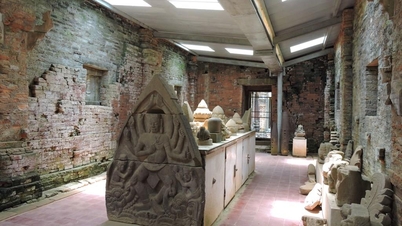First, let's analyze each word:
The character "Tí" (比) first appeared in oracle bone script during the Shang Dynasty. Many researchers believe that "Tí" (比) resembles two people standing next to each other or two spoons placed next to each other, because the character " Chuy" (匕) means "spoon". Some scholars speculate that "Chuy" (匕) is the original form of the character " Tí" (arm). Two characters "Chuy " (匕) placed next to each other form the character " Tí" (比), which means two arms placed next to each other. Thus, no matter how it is explained, all points of view conclude that the original meaning of "Tí" is "next to each other".
From there, " ti " leads to the understanding of "near or parallel" (Book of Songs, Zhou Tung) and then another meaning is "comparison" (Zhou Li, Tian Guan, Noi Te) ; or expanded to "example" (Book of Songs, Boi Phong, Bac Phong) ; "ti chieu" (comparison) and "phong chieu" (based on what is available)...
The character "shi" (譬) is a pictographic phonetic character, the original meaning is "shi nhu" (for example), "ti di" (Poetry, Xiao Ya, Xiao Bian) ; later it means "to make known, to make understood" (Book of the Later Han) . This character is popular in pre-Qin classics, often used with the character "ru" (如), for example: " ti nhu bo loc " (for example, catching deer) - Zuo Zhuan. Duke Xiang, 14th year .
Now comes the word ví , a character that means "as, if, suppose, though".
Ví is not a Sino-Vietnamese word but a Nom character with 3 ways of writing: 𠸠 (a "pure Nom" character); and 彼 and 啻 are borrowed from Chinese. Tran Te Xuong once wrote a Nom poem as follows: " Vi (啻) is equal to the state's allowance for you to pass. Then how much money can you earn in a month?" (Vi Thanh Giai Cu Tap Bien) .
Next is the character喻 (yu), a character first known in Seal script in Shuowen Jiezi , combining two characters:口(mouth) and俞(boats passing through a river gate). The meaning of yu is that any boat passing through a river gate must declare and be inspected by the person in charge of the river gate. Therefore, the original meaning of yu is to explain or inform, later the meaning expanded to communication, understanding; and the meaning in this article is "example, simile and comparison"...
Example (比 喻), also known as example, example, example, comparison, comparison . This term is a type of rhetorical device, based on the similarity between two things, thing B is used to compare thing A.
Nowadays, there are many forms of metaphor , such as metaphor (extended comparison); inversion (reverse comparison); allegory (comparison with evidence) or antithesis (comparison with opposition); hypothesis (comparison with association); or allegory (sarcastic comparison) and sub-metaphor (implicit comparison, allusion ) ...
Example (譬喻) is a word first found in Xunzi. Fei Shierzi in the Warring States period, the usage is similar to today's example and example .
Although we can use the words "for example, for example, for example" interchangeably, in our opinion, using the word "for example " is the most reasonable, because "for example" has become an old word, rarely used, while "for example " is a "half-fat, half-lean" word (Nom + Han).
In addition, please note, there are Sino-Vietnamese words that are synonymous or near-synonymous with "for example, for example, for example", such as "cu le, hao ti, hao tu, huu nhu, kham tu, le nhu, nhu dong, thi nhu, ti phuong"...
Source: https://thanhnien.vn/ti-du-thi-du-vi-du-185250718215610368.htm


![[Photo] Party Committees of Central Party agencies summarize the implementation of Resolution No. 18-NQ/TW and the direction of the Party Congress](https://vphoto.vietnam.vn/thumb/1200x675/vietnam/resource/IMAGE/2025/10/27/1761545645968_ndo_br_1-jpg.webp)


![[Photo] The 5th Patriotic Emulation Congress of the Central Inspection Commission](https://vphoto.vietnam.vn/thumb/1200x675/vietnam/resource/IMAGE/2025/10/27/1761566862838_ndo_br_1-1858-jpg.webp)

![[Photo] National Assembly Chairman Tran Thanh Man receives Chairman of the House of Representatives of Uzbekistan Nuriddin Ismoilov](https://vphoto.vietnam.vn/thumb/1200x675/vietnam/resource/IMAGE/2025/10/27/1761542647910_bnd-2610-jpg.webp)





































































































Comment (0)